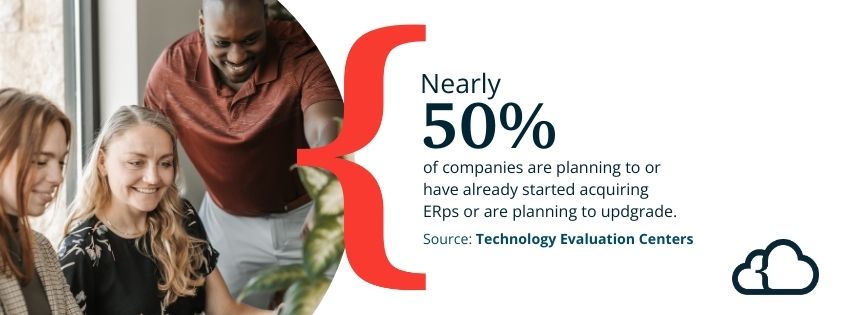25 Essential ERP Statistics: Exploring Implementation Data and Market Trends
The numbers show ERPs boost productivity, customer experience, standardization, and more—keeping businesses on the cutting edge of their industries.
An enterprise resource planning (ERP) system can drive the growth strategy of any organization that's praying to the business gods for expansion. It’s the heart of a company—the software that feeds every department and keeps all operations working together.
The latest ERP statistics show companies now understand how essential this software has become in today’s business world. They also realize how such systems can shoot a company into the financial stratosphere by streamlining processes, boosting productivity, providing new forms of business intelligence, and more.
And they want a piece of that pie.

25 ERP Statistics You Should Know
If you’re considering an ERP purchase, you should know how well these systems have worked for other companies. Peruse the numbers and discover how many companies are adopting this technology, why they’re implementing it, and what they may have done right or wrong in the process.
ERP Trends
This technology’s popularity is growing faster in the business world than ChatGPT in high school classrooms. And ERP statistics are showing preferences for cloud hosting and software-as-a-service deployment models.
1. Almost 50% of companies are planning to or have already started acquiring ERPs or are planning to upgrade.
2. The top three reasons businesses buy new ERPs are to replace outdated legacy systems, consolidate disparate applications, and update to the latest technologies.
3. A 2023 ERP report revealed that 64.5% of businesses surveyed use cloud ERPs instead of on-premises systems.
4. Slightly more than half (51.7%) of those organizations using cloud ERPs selected SaaS deployment models over hosted or managed services.
5. The same report stated that 65.6% of businesses implemented ERP/IT improvement projects with moderate to heavy customizations.
6. 62.1% of surveyed companies using third-party consultants sought software implementation assistance. Additionally, 50.6% said they needed technology assistance, and 41.4% wanted business process management or reengineering.
ERP Market
The latest ERP statistics depict a hungry global market with no signs of slowing down. Experts seem to predict only wild growth.
7. According to Gartner, the ERP software market grew by 8% to a $44 billion market value in 2022.
8. Experts believe the global ERP software market will grow at a CAGR of 9.93% from 2022 to 2027. That’s an increase of more than $29 billion.
9. North America is expected to make up 42% of the global ERP market by 2027.
10. Experts believe the global cloud ERP market will reach $40.5 billion by 2025. It was valued at $14.7 billion in 2018.
11. The global market value for all ERP software is expected to reach $117 billion by 2030.
ERP Cost
Unfortunately, determining the total cost of any system can get tricky. Many businesses want customized systems, which often require extra software and services. Even businesses that purchase SaaS systems with set subscription prices discover hidden costs—because nothing is simple in the software world.
Even so, ERP statistics show that these systems typically cost a small portion of annual company revenue.
12. According to a recent digital transformation report, mid-sized companies ($50 million to $1 billion in annual revenue) said their ERPs’ total cost of ownership equaled 3% to 5% of their annual revenue.
13. Large companies ($1 billion + in annual revenue) reported a total cost of ownership equaling 2% to 3% of their annual revenue.
14. According to that report, several variables affected implementation time and cost. Scope, magnitude of change, operational complexity, level of organizational support, and extent of software customization had the most impact.
15. 53% of respondents to another 2023 survey said their ERP/IT improvement projects stayed on or under budget. Only 9.3% said their projects ran significantly over budget.
16. Respondents who went over budget listed various reasons for their spending.
- Underestimated Project Staffing – 38.4%
- Expansion of Initial Project Scope – 34.9%
- Technical Issues – 33.7%
- Data Issues – 33.7%
- Additional Technology Needed – 32.6%
- Organizational Issues – 29.1%
- Underestimated Consulting Fees – 17.4%
ERP Timeline
We wouldn’t blame you for expecting most ERP implementations to encounter issues and blow past their deadlines. Software systems this complex have earned reputations for harboring bugs and glitches, causing more headaches than they soothe.
Surprisingly, that’s not the case here. ERP statistics show many projects stay on schedule, and companies reach go-live when planned.
17. Most implementations take 14-16 months for midsized companies ($50 million to $1 billion in annual revenue).
18. Implementations for larger companies ($1 billion + in annual revenue) typically take 31 to 34 months.
19. 57.9% of businesses surveyed in a 2023 ERP report said their ERP/IT improvement project was completed on time or earlier than anticipated. Another 30.6% said it was completed only slightly later than anticipated.
20. Respondents whose projects ran over schedule gave various reasons for this.
- Technical Issues – 42.9%
- Initial Project Scope Expanded – 40.3
- Resource Constraints – 37.7%
- Organizational Issues – 35.1%
- Data Issues – 31.2%
- Unrealistic Project Timeline – 29.9%
- Vendor Didn’t Deliver Promised Functionality on Time – 11.7%
ERP Issues
Despite the previous numbers, we admit systems do encounter implementation issues. A business may work hard toward go-live, only to discover that the new software won’t ship products or close the books.
ERP statistics show these problems happen regularly. Choose your consultants and implementation partners carefully to give your system the best chance of success.
21. A 2023 digital transformation report says 51% to 54% of surveyed companies experienced operational disruption at go-live. Those companies also saw a 50% to 300% increase in implementation costs.
22. Several variables affected those operational disruptions. The following factors had the most impact.
- Clarity of Defined Business Processes
- Investment in Organizational Change and Training
- Level of Executive Alignment Among Main Stakeholders and the Transformation Project Team
- Time and Effort Spent During User Acceptance Testing and Conference Room Pilots
ERP ROI
So, here’s the ultimate question: Do these systems really work as well as advertised? In a word, yes.
ERP statistics say companies are typically happy with the software’s return on investment (ROI) and believe the systems have improved business.
23. According to a recent survey, companies reach ROI on their ERP software an average of 2.2 years after implementing it.
24. A 2023 ERP report says 83% of businesses that have been live for a year and performed ROI analysis before the project said their systems met their expectations.
25. Large percentages of surveyed businesses that have been live for at least a year felt their ERP/IT improvement projects met expectations in several key areas:
- Inventory Levels – 90.9%
- Productivity/Efficiency – 77.7%
- Removing Siloes – 77.3%
- Interactions with Suppliers – 76.2%
- Compliance – 75.4%
- Customer Experience – 70.1%
- IT Maintenance Costs – 68%
- Real-Time Data – 65.9%
- Operating and/or Labor Costs – 63.9%
- New Operating Models – 60.5%
- Standardization – 58.4%
What Do These Numbers Mean for You?
These 25 ERP statistics prove the software can help businesses reach new heights in their industries. ERP software touches every aspect of a company—from its inventory levels to its customer experience—and ramps up efficiency and productivity. Think of these systems as technological steroids for your business.
But the numbers also warn that organizations must proceed with caution. Issues such as unrealistic goals and poor planning can severely hamper an ERP implementation project, causing it to run over budget and past deadline. And, consequently, company bosses can grow very, very unhappy.
So, choose your system and implementation partner carefully. The wrong software and consultant will cause more problems than they solve.
We should know. Our CEO built this company to provide positive NetSuite implementation experiences when other consultants failed.
Blow Away the Competition
Stop fighting a software system that's working against you. Instead, enjoy the benefits of an ERP that knits your operations together seamlessly and provides the data and analysis you need to trounce your competition.
We know you can rise in your industry.
Team up with SuiteDynamics to develop the ERP system your business needs. As NetSuite solution providers, we license, customize, and implement NetSuite ERP software for clients in any industry.
The partnership doesn't stop there. We can continue working together long after go-live, maintaining the system, training staff, and adjusting the software to accommodate your expansion. So, start by contacting us for your free NetSuite demo.
Published: July 21, 2023












